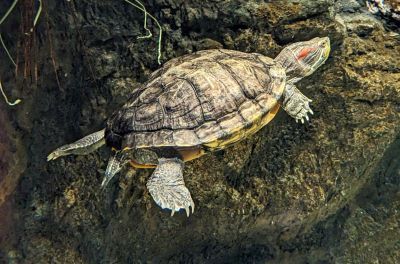
Good Natured: It's Turtle Time
Wakey wakey, eggs and bakey!
Despite not being much of a morning person, I've always roused from even the deepest sleep when breakfast is served. The siren song of a hearty breakfast sizzling on the stove—along with the promise of COFFEE—lures me to the kitchen where, if I'm not careful, I'll spend an hour lingering over eggs, bacon and, on truly extravagant days, pancakes too.
We've actually got a similar situation going on right now in our northern Illinois ponds and streams-well, minus the eggs, bakey and pancakeys.
For the past several months our local turtle species—namely painted turtles and sliders, spiny soft-shelled turtles and snappers—have been in a state of suspended animation known as brumation. Similar to hibernation (which is a phenomenon of warm-blooded, or endothermic, animals) brumation is a strategy our cold-blooded, or ectothermic, animals employ to survive the cold-weather months.
For aquatic turtles, brumation means spending the cold weather months at the bottom of their home pond or stream. As long as that body of water doesn't freeze solid, the water—even though it's really cold—will provide Shelly and Co. with the oxygen they need to survive.
“Wait!" you might be thinking. “Turtles don't have gills. How the heck are they going to breathe underwater?"
It's true, during the warm-weather months, when reptile activity levels are their peak, reptiles breathe air. In fact, an active turtle can drown if trapped underwater. But during brumation, some remarkable adaptations kick in.
Cold temperatures cause turtles' metabolism to slow down dramatically. The heart beats only once every few minutes. Respiration slows too, and takes place in an entirely different way.
Instead of using their lungs and breathing air, turtles switch to cloacal respiration. Long-time Good Natured readers might recall that the cloaca is a cavity at the base of the body, into which intestinal, urinary and genital tracts empty. In simpler terms, it's the Swiss Army Knife of orifices.
At any rate, within this multipurpose region, as well as in the skin and throat/mouth, turtles develop highly vascularized tissue through which they absorb oxygen present in the water. Whether you use the formal description cloacal respiration, or the coarser term “butt breathing," the effect is the same: It's an amazing adjustment that works incredibly well.
Except when it doesn't.
In a turtle's perfect world, it would be the only organism inhabiting its aquatic habitat. It wouldn't have to share resources like food in summer and oxygenated water in winter.
But in real life, many creatures, including fish, frogs and a wide range of invertebrates, also are living in that underwater space. Under certain circumstances, like in small ponds that become completely covered in ice, that dissolved oxygen is in high demand. Sometimes it even runs out.
You might have seen the aftermath of such an event, the form of a fish kill. I remember getting several calls a few years ago when the pond at Timber Trails Park in St. Charles was frozen for an extended period. When the spring thaw came, hundreds of fish (including lots of goldfish that had been “given their freedom") floated on the pond's surface.
Curiously enough, we didn't see any turtles, even though that pond is full of them.
That's because when the going really gets tough, turtles have yet another trick up their sleeve. Er, shell. They switch things up yet again, to an absolutely astounding process called anaerobic respiration. It's a form of survival that required no oxygen at all!
This condition can't last forever (100 days is what has been achieved in laboratory situations) and it comes with the unpleasant consequence of lactic acid buildup. To neutralize the acidic condition and the cramping it will cause, turtles turn to the calcium stored in their shell.
I should add, this option isn't available to all aquatic species. Softshell turtles, for example, are very intolerant of anoxic conditions and therefore are found only in large lakes and rivers.
With the mild winter we just had, most local ponds weren't frozen for long and anaerobic conditions did not develop. Still, turtles—and lots of humans too—are ready for the change of season.
They might not be eggs and bakey, but spring's longer days and stronger sunshine are starting to exert their impossible-to-ignore influences on painted turtles, sliders, softshells and snappers. When daytime temperatures hit the 60s, and the sun shines high in the sky, the earliest risers will be heading up and out of the water, onto logs and rocks for some much-needed basking time.
Wakey wakey!
Pam Otto is the outreach ambassador for the St. Charles Park District. She can be reached at potto@stcparks.org.

